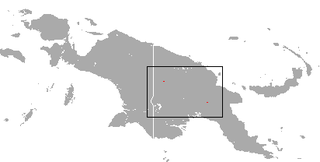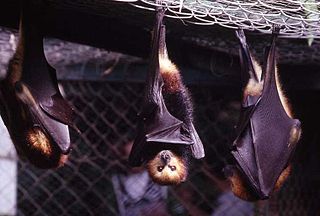
The white-billed crow is a member of the crow family found on the Solomon Islands.

Bulmer's fruit bat is a megabat endemic to New Guinea. It is listed as a critically endangered species due to habitat loss and hunting. It is the only member of the genus Aproteles. Due to its imperiled status, it is identified by the Alliance for Zero Extinction as a species in danger of imminent extinction.

The Mauritian flying fox, also known as Greater Mascarene flying fox or Mauritius fruit bat is a large megabat species endemic to Mauritius and La Réunion.

Dermanura is a genus of leaf-nosed bats.
Aethalops is a genus of megabats in the family Pteropodidae. It contains two species:

Melonycteris is a genus of megabat in the family Pteropodidae. Members are found in the Solomon Islands or in the case of the Black-bellied Fruit Bat, in Papua New Guinea.

Fardoulis's blossom bat is a species of bat in the Pteropodidae family. It is endemic to the Solomon Islands. Its natural habitat is subtropical or tropical moist lowland forests. It is threatened by habitat loss.

The black-bellied fruit bat is a species of order Chiroptera in the family Pteropodidae.

The Malaita tube-nosed fruit bat is a species of bat in the family Pteropodidae. It is endemic only to the islands of Malaita and Makira in the Solomon Islands. The species occurs in primary tropical moist forest.

The demonic tube-nosed fruit bat is a species of bat in the family Pteropodidae. It is endemic to Papua New Guinea. The holotype specimen was collected in 1979 on New Ireland, in the Bismarck Archipelago. It was described as a new species in 1983. The range of the species may extend to other islands, however the extent of the range is not presently known.

The Philippine tube-nosed fruit bat locally known in Tagalog as Bayakan is a species of bat in the family Pteropodidae. It is endemic to the Philippines and known from the islands of Cebu, Negros and Sibuyan. It occurs in and near primary and secondary subtropical or tropical dry forests. It is often found near water. It is threatened by habitat loss due to deforestation. The species is named for Dioscoro S. Rabor who, with several others, first collected the species.

The Rodrigues flying fox or Rodrigues fruit bat is a species of bat in the family Pteropodidae, the flying foxes or fruit bats. It is endemic to Rodrigues, an island in the Indian Ocean belonging to Mauritius. Its natural habitat is tropical lowland forests. The bats are sociable, roost in large groups during the day and feed at night, squeezing the juice and flesh out of fruits. They are hunted by humans for food and their numbers have been dwindling, and the International Union for Conservation of Nature has rated the species as being "endangered". In an effort to preserve them from extinction, some bats have been caught and are being bred in various zoos around the world.

The dwarf flying fox, least flying fox, or least fruit bat is a species of flying fox in the family Pteropodidae. It is endemic to the Solomon Islands. It is threatened by deforestation, which is believed to damage roosting sites in old growth forests.

The Pteropodinae are a subfamily of megabats. Taxa within this subfamily are:

The megabat tribe Macroglossini is within the subfamily Pteropodinae

Thomas's fruit-eating bat, sometimes also popularly called Watson's fruit-eating bat, is a species of bat in the family Phyllostomidae. It is found from southern Mexico, through Central America to Colombia. Its South American range is to the west of the Andes. The species name is in honor of H. J. Watson, a plantation owner in western Panama who used to send specimens to the British Natural History Museum, where Oldfield Thomas would often describe them.
















